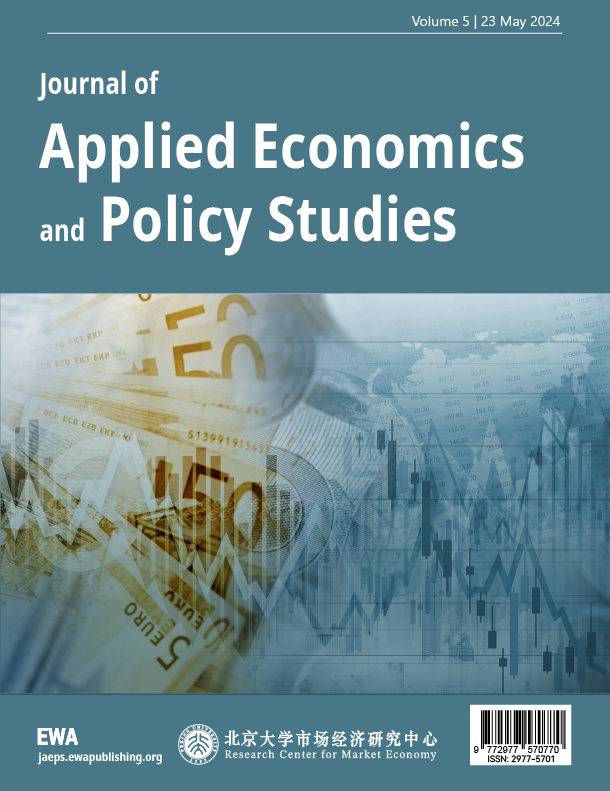1. Introduction
Organizations which can function beyond national borders are known as Transnational Corporations (TNCs), and they often hold considerable economic, social and political influence. They affect the dynamics on a global scale, which in turn influences sustainable development in many ways. Transnational Corporations' (TNCs') vast networks, substantial resources, and widespread market reach can benefit or harm efforts toward sustainable development. The role of TNCs in accomplishing the United Nations' Sustainable Development Goals (SDGs) is garnering more attention and criticism as the international community wrestles with urgent concerns including environmental degradation, impoverishment, and socio-economic inequality. TNCs' contributions to the SDGs are significant because of the extraordinary scale at which they may deploy financial, human, and technical resources. In addition, their extensive worldwide networks make it possible for them to adopt and promote sustainable practices across national boundaries, making them crucial members of the international effort to achieve the SDGs by 2030. However, these same features also suggest that multinational firms may contribute to negative global effects if they are not managed by sustainability and ethical business practises.
With distribution in over 200 countries, Coca-Cola exemplifies the global reach of a transnational company. The firm has made major contributions to both developed and developing economies, influencing several sectors of the economy and the lives of countless individuals. As a result, learning from Coca-Cola's policies and practises may provide light on how Transnational Companies (TNCs) might aid in the advancement of sustainable development on a worldwide scale. This report's goal is to assess Coca-Cola's current efforts and their potential to advance the Sustainable Development Goals. The company's current attempts to integrate the SDGs into its business model will also be examined, along with the challenges it has faced and the opportunities it has missed. In addition to assessing the company's efforts to advance the SDGs, it will also investigate any gaps in policy that may impede the SDGs' advancement. The analysis will also investigate why Coca-Cola is pursuing sustainable development, with the goal of elucidating how these initiatives fit into the larger framework of the company's business strategy and CSR goals.
The report the report is structured as follows; Brief introduction, literature review, examination of Coca Cola's CSR strategies, alignment with SDGs, and the benefits derived from these practices. Citing the role of companies in global sustainable development, the paper concludes with suggestions for improvement and a summary of significant results that tie back to the literature review.
2. Literature review
The United Nations Commission on Environment and Development pioneered the notion of sustainable development in its 1987 report, "Our Common Future," and the idea gradually made its way into national priorities [1]. The research report recommended a course of action known as "sustainable development" to ensure the well-being of future generations without compromising the necessities of the present. The United Nations officially put sustainable development on the global agenda in 1992 when it hosted the Rio Earth Summit, where major international agreements like the United Nations Framework Convention on Climate Change and the Convention on Biological Diversity were adopted, as well as the Rio Declaration and the Rio Agenda. Thus, in 2015, the UN came up with the Sustainable Development Goals (SDGs). In order to attain equitable prosperity and sustainable development for everyone, the SDGs were suggested to deal with the world's environmental, social, and economic problems. These objectives seek to spur international action on sustainable development to combat a wide range of problems, including global warming, environmental degradation, poverty, inequality, and food insecurity [2]. Promoting global economic development, social advancement, and ecological balance may guarantee sustainable future if these objectives are met. These objectives are a call to action for governments, businesses, and people to improve their respective sectors and the world as a whole via sustainable means. The future of mankind and our planet depends on our ability to work together to accomplish the SDGs.
Given the growing urgency of the issue, the relationship between business and sustainable development has risen to the forefront of academic debate in recent years. Given their size and reach, TNCs have been the focus of numerous debates. Many researchers have examined how Corporate Social Responsibility (CSR) has developed from simple adherence to rules and regulations to active participation in social and environmental projects [3, 4]. Businesses may improve their standing in the eyes of their stakeholders and public while doing good for the world at large via Corporate Social Responsibility (CSR) initiatives [5]. CSR is a dynamic field of study because of its ever-changing nature. It is seen as more than just a duty; it's a chance for businesses to develop and implement moral policies that go above and beyond what's required by law. Since corporations now affect both society and the environment, they play a more pivotal role in global sustainable development.
Historically, CSR has evolved from a response to social and environmental issues to a more proactive, purposeful involvement with these issues. At first, CSR focused more on 'doing no harm' and obeying laws and regulations, making sure that firms were playing by the rules. The concept of corporate social responsibility (CSR) has evolved to include more proactive initiatives, in which companies not only comply with the law but also actively strive to make beneficial contributions to society and the environment [4] For businesses, CSR has evolved into a strategy for creating shared value, which means they aim to profit from the market in a manner that also benefits society by finding solutions to problems it faces. This strategy is more than just charitable giving. It creates a balance between a company's bottom line and its positive social or environmental effect by integrating corporate social responsibility into the core of the business. Moreover, the company's image and relationships with its many stakeholders might benefit from the incorporation of CSR into the company's core business plan. Creating value for all stakeholders is essential for a successful firm in the 21st century, according to Freeman et al. [5]. They imply that organizations with a CSR strategy centered on their stakeholders would be the most successful and resilient over time.
The scholarly discussion of TNCs contribution to the SDGs often centers on the extent to which their business plans and activities are informed by the SDGs [6]. According to Scheyvens et al. [7], TNCs may make substantial contributions to the SDGs through ethical investment choices, the creation of new jobs, the dissemination of technological advances, and the maintenance of environmental norms. The authors warn, however, that if TNCs don't operate in accordance with sustainable and socially responsible principles, they might make inequality and environmental degradation worse. Case studies, like those centered on Coca-Cola, provide valuable insights into how TNCs handle the difficulties of contributing to the SDGs while pursuing economic goals.
3. Company overview Coca Cola
the well-known American global business, began in the soft drink market. The corporation, which has been around since 1886, is now a worldwide powerhouse that represents American entrepreneurship at its finest. It's headquarters is in Atlanta, Georgia, but the company's reach is really global, as it has established itself in more than 200 nations across the globe. The company is well-known for its wide variety of products; it offers over 500 different flavors, both carbonated and non-carbonated. Coca-Cola may be the most well-known product, but the firm really produces a wide variety of drinks for a variety of demographics and geographies. Beverages of this kind range from carbonated soft drinks and bottled water to natural juices, coffee, sports drinks, and energy drinks. There are 21 brands [8, 9] here that each bring in over a billion dollars a year in revenue for their respective retailers. As of 2022, Coca-Cola had employed approximately 86,200 people around the globe, making it a major economic player in many of the regions in which it operates. This sizable group of people is essential to the success of the business in many different ways, from research and design to production and distribution.
According to Li, Coca-Cola's strong market presence and financial muscle were on display in 2022 [10], when the company recorded sales of around $37.27 billion. It's impressive that despite global economic uncertainty and shifting consumer tastes, the firm has continually maintained excellent sales growth. Coca-Cola's supply chain, brand awareness, and product variety all contribute to the company's ability to weather economic storms. The firm competes head-on with major players such as PepsiCo and Nestle Inc. in the beverage market. The company has responded to the intense competition in the soft drink market by constantly developing new products and exploring fresh channels of communication with its target audience. Many of the company's rivals have also begun to take efforts to address environmental and social challenges in their operations, which has affected the business's commitment to sustainability and corporate social responsibility [11]. Coca-Cola's ability to reach customers in every part of the world owing to its efficient and extensive distribution network [6, 11] is one of the company's greatest assets. Its approach for getting its goods to customers is to form partnerships with local bottling firms for production, packaging, and distribution. This enables Coca-Cola to cater to regional preferences, which has contributed to the brand's enduring success in many areas throughout the world.
4. Coca Cola's contribution to sustainable development goals
Coca-Cola is a major participant on a worldwide scale, thus the company's actions will surely have an effect on many facets of sustainable development. Over the years, the corporation has adapted its approach to fit the UN's 2030 [9] Agenda for Sustainable Development, and it has launched projects that advance various SDGs.
4.1. SDG 6: clean water and sanitation
Coca Cola acknowledges that water is essential to its operations and the environments in which it works. So, the business has made great achievements in water management, especially through its "Replenish" initiative. By the year 2020, Coca-Cola had successfully returned to nature and communities an amount of water equal to the volume of all of its completed products [8]. The company is dedicated to responsible water management in more ways than simply water replenishment. It has implemented a comprehensive water management policy with three primary goals: decreasing water use, recycling water for safe reuse, and restocking water supplies in local communities [8]. It has been working to minimize its water use and has set a goal of increasing its water efficiency by 25% by 2020 relative to a baseline year of 2010 [8]. Various water-related initiatives have been made possible due to the company's partnership with local communities, municipalities, and NGOs [6]. The scope of these initiatives includes both watershed preservation and water supply for underserved areas. The company has positioned itself as an active contributor in attaining SDG 6 by incorporating these activities into its core business operations [11].
4.2. SDG 8: decent work and economic growth
The effects of Coca-Cola's business on national and international economies are significant. Due to its massive manufacturing capacity, Coca Cola is one of the largest employers worldwide [9]. The corporation promotes economic progress in the nations in which it works by offering secure employment and room for professional advancement, therefore contributing to SDG 8. Its efforts, such as the Supplier Guiding Principles (SGP) program, aim to ensure fair labor standards across its supply chain [11], which reflects the company's commitment to 'Decent Work'. Coca-Cola's 5by20 program is an example of the company's efforts to improve the lives of its customers and the community at large, especially those of women. This initiative is to encourage local entrepreneurship by making available training, financial services, and mentoring [8]. Initiatives like 5by20, which aim to increase the participation of women in the economy, support both SDG 5 (Gender Equality) and SDG 8 (Good Jobs and Economic Growth) by providing economic possibilities to women [11].
4.3. SDG 13: climate action
By committing to a 25% reduction in its carbon footprint by 2020 compared to 2010 levels [8], Coca-Cola is showing its support for Climate Action (SDG 13). The dedication demonstrates the firm's understanding of the role major firm’s play in causing global warming, notably in the industrial sector [7]. As shown in fig. 4,5,6 Coca-Cola has made significant gains toward optimizing its energy consumption, investing in renewable energy sources, and reducing greenhouse gas emissions across its direct operations and supply chain. The firm has introduced energy-efficient coolers, optimized its production processes to reduce energy use, and urged its suppliers to do the same.
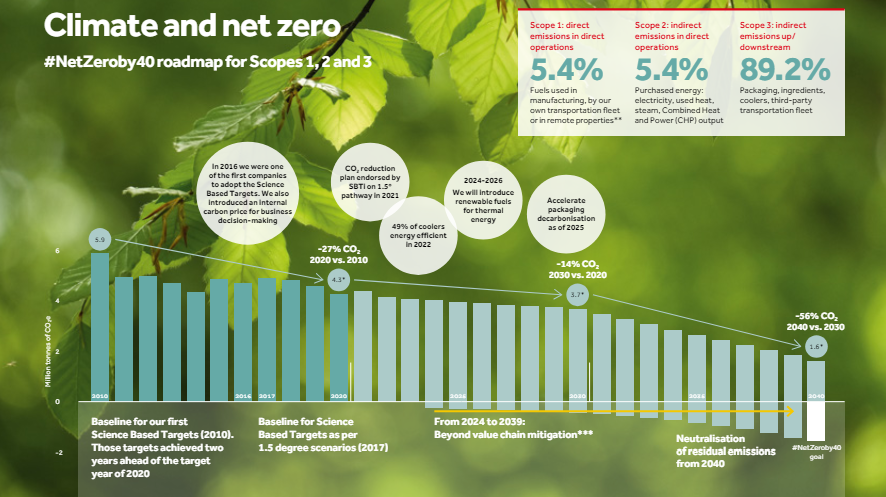
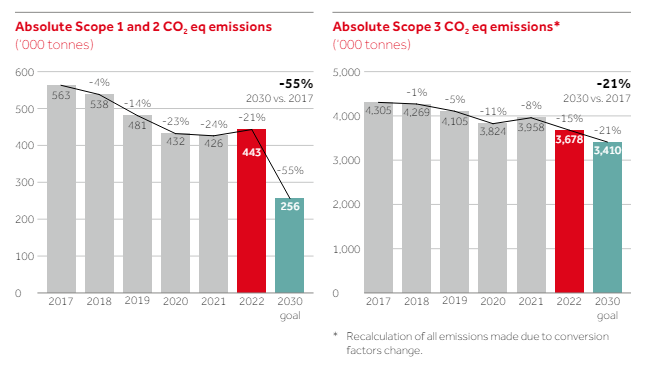
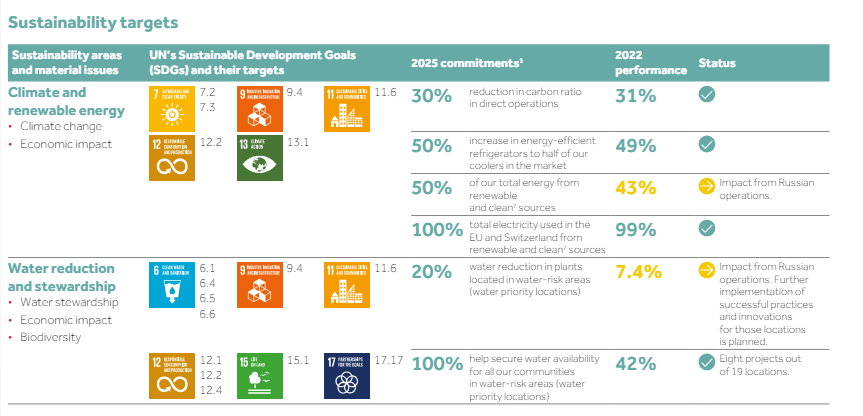
4.4. SDG 3: good health and well-being
Coca-Cola's efforts to lower sugar content in its drinks and encourage active lifestyles are indicative of the company's dedication to Sustainable Development Goal 3 [8]: Good Health and Well-being. Coca-Cola has reformulated some of its products and added others that are low in sugar or sugar-free in response to customer demand [9]. Coca-Cola's efforts in this area show the company's dedication to improving public health by encouraging individuals to choose more nutritious beverage choices [11]. Coca-Cola is serious about encouraging healthy living, as seen by its worldwide commitment in fitness initiatives [8]. The company's support for SDG 3 is shown using its collaborations with fitness and wellness groups to promote the value of exercise. While we applaud Coca-Cola's efforts to address the issue, we remain concerned about the company's sugary drinks notwithstanding these efforts. Obesity and diabetes are only two of the many health problems that have been related to excessive sugar consumption, which is typically tied to the regular intake of sweetened beverages. Coca-Cola's contribution to SDG 3 might be bolstered if the company offered a wider variety of healthier alternatives and increased its efforts to educate customers about the possible health implications of excessive sugar intake. As the following curve shows, the corporation has made steady progress in lowering its rate of accidents per million vehicle-kilometres(As shown in Pig7: CocaCola, 2022 p.42) travelled over the last decade, with 2022 being the eleventh consecutive year of reduction.
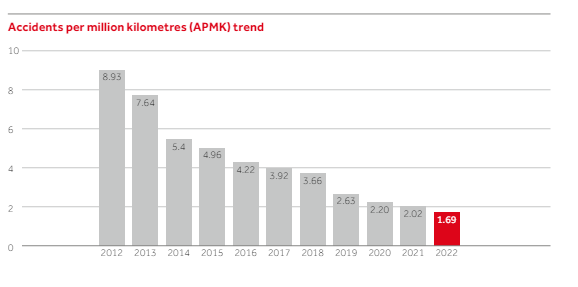
4.5. SDG 5: gender equality
Coca-Cola's 5by20 project is a program that aims to economically empower 5 million women entrepreneurs by the year 2020, demonstrating the company's commitment to attaining Gender Equality (SDG 5). The corporation understands the positive impact that women business owners can have on economies, communities, and society at large. By facilitating access to financial services, business skills training classes, and mentorship programs, the project has worked to remove obstacles to women entrepreneurs. Because it provides women with the support they need to succeed in business, this proactive step has been crucial in advancing the cause of gender equality and women's empowerment. Also, by equipping participants with a set of skills that are relevant in the modern economy, the company's main community program hopes to reduce the rates of young unemployment and educational inequality. Training is provided both in-person and virtually, and top management from Coca-Cola HBC are available for mentorship and networking [9]. Since its start in 2017, #YouthEmpowered has impacted the lives of nearly 790,000(As shown in Fig8: Coca Cola 2022, p.48) ).
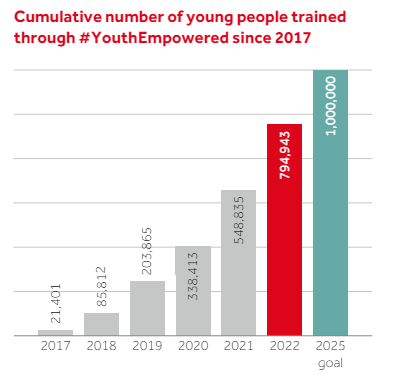
5. Strategic approach to CSR and sustainable development
Coca-Cola's approach to corporate social responsibility (CSR) is centred on proactive measures that have an effect beyond mere compliance with legal mandates. In the CSR strategy paradigm presented by van Tulder and van der Zwart, this method falls under the "proactive" category. A considerable commitment to CSR is shown by adopting proactive methods that look forward to public expectations and willingly adjust processes to satisfy societal needs [4]. Several major projects show Coca-Cola's proactive approach to business. As may be seen in the following figure, the company's World without Waste campaign demonstrates the firm's dedication to a circular economy. By 2030 [9] it plans to collect and recycle one bottle or can for everyone it sells. The firm is making strides toward this goal by increasing the proportion of recycled content in its bottles and switching to 100% recyclable packaging [8]. The company's water stewardship initiatives also show a planned strategy. Coca-Cola has promised to refill all of the water that goes into making its drinks and packaging them, in light of the rising worldwide water issue. Coca-Cola has returned more water to the environment than it consumes worldwide, surpassing its original objective [8]. It's proof that Coca-Cola cares about the environment and wants to do more than just comply with legislation [4].
The 5by20 campaign, which promotes women's empowerment, is another preventative measure taken by the corporation. By 2020, Coca-Cola plans to have helped 5 million women business owners throughout its value chain become financially independent [83]. Beyond the typical responsibilities of a global organisation, the firm has taken this step because it recognises the importance of its position in society and the impact it may have on social concerns [5]. Coca-Cola is actively working to integrate its company aims with the larger sustainable development goals via a number of proactive methods. Nonetheless, it's worth noting that the corporation has been heavily criticised despite its aggressive measures. Obesity and other chronic illnesses have been linked to use of Coca-Cola products, which has prompted criticism from health activists [12]. Despite their best attempts to move towards a circular economy, environmentalists nonetheless hold the firm accountable for its large plastic pollution impact [7]. Because of this proactive approach, Coca-Cola has come a long way towards achieving its goal of sustainable development [6] (As shown in Fig9: World without Waste. Extracted from coca cola 2021, p.32). However, for the company's long-term viability, it is essential to directly address the objections, particularly those connected to the health effect of the product and plastic pollution [7]. In order to effectively deal with these issues, businesses must further incorporate sustainable practises into their fundamental business strategy, where financial and social success are interdependent and reinforce one another [3].
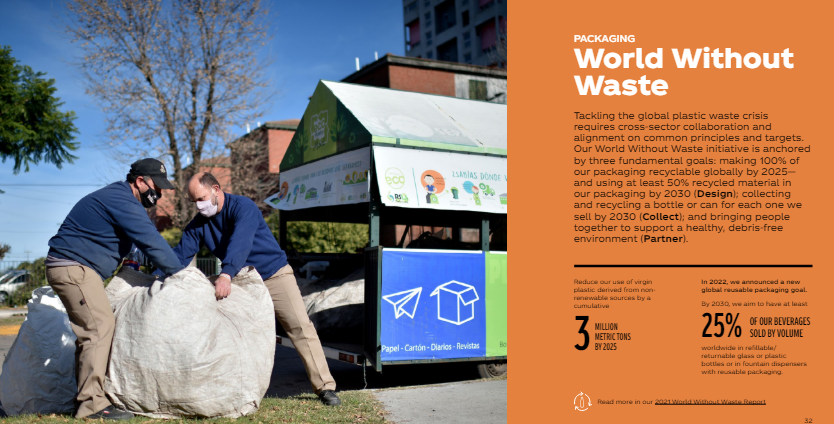
6. Benefits from adhering to the SDGs
The Sustainable Development Goals (SDGs) have provided several advantages for The Coca-Cola Company that go well beyond the company's public image. These gains are significant strategic advantages that may have a major effect on the company's environment and operations. Improving Coca-Cola's public profile is the first of these advantages [11]. Customers that care about social responsibility appreciate the company's initiatives to promote sustainable packaging [9], water conservation [8], and women's economic development, such as the 5by20 programme. Coca-Cola's market dominance and long-term growth are bolstered by the company's commitment to values shared by its target audience [3].
Furthermore, there has been a shift in customer taste, with an accompanying surge in interest in eco-friendly goods and services [7]. Coca-Cola gains an advantage in the highly competitive beverage industry by aligning its operations with the SDGs [6]. For instance, the company's efforts to provide eco-friendly packaging options are likely to increase the company's market share and bottom line since they appeal to the growing number of consumers who are concerned about the environment [9]. The risk reduction advantages of Coca-Cola's commitment to the SDGs are substantial. Particularly in water management, the SDGs emphasise global concerns that might have far-reaching repercussions for enterprises [2]. Coca-Cola's commitment to sustainable water management is in line with SDG 6 (Clean Water and Sanitation) [11], helping to reduce the likelihood of operational interruptions caused by water shortages [6].
Furthermore, the company's dedication to the SDGs may act as a spur to innovation [11], leading to the creation of novel business models, merchandise, and solutions. Coca-Cola has made it clear that it takes issues about plastic pollution and sugar content seriously by consistently working to improve its packaging solutions and provide new, healthier beverage choices. Coca-Cola can only get the full advantages of its SDG alignment if it goes above and beyond just launching corporate programmes that are reflective of these objectives. The SDGs must become an integral part of the company's overall business plan, and serious concerns must be addressed head-on. Certain of Coca-Cola's practises run counter to the health and environmental goals of the SDGs, such as the high sugar content of certain of its drinks [12] and its significant contribution to plastic pollution. Coca-Cola can better align with the SDGs if it takes measures to proactively address these concerns, such as reformulating beverages to lower sugar content and developing packaging to minimise plastic consumption. This will help the firm gain an advantage in the market and contribute more meaningfully to global sustainable development by establishing itself as an environmental leader in the beverage sector [4].
7. Recommendations
Coca-Cola's efforts to expand its product line to include healthier choices have been successful to a certain extent [8]. The worldwide prevalence of obesity and diabetes are both directly linked to the high sugar content of many of its drinks [12]. Coca-Cola has to spend more money on R&D to find ways to reduce sugar in their drinks without sacrificing flavour [12]. Extending its current ranges of low- or no-sugar products and looking into natural sweeteners are two possibilities [9]. It may also help promote these healthier alternatives, raising public interest and driving up demand [7]. Coca-Cola has pledged to reduce its carbon emissions [9], but given the severity of the climate issue, it is essential that the company increase the pace at which it does so [7]. To do this, it may switch to renewable energy for all of its activities [9], deploy energy-efficient technology [11], and push its vendors to do the same [9]. Investment in carbon capture systems may also help reduce emissions from manufacturing [6]. In addition, the organisation may prepare for the future by conducting a thorough risk assessment and action plan related to climate change [2].
Standardising labour practises across Coca-Cola's broad supply chain is difficult yet important given the company's size and scope [11]. Coca-Cola needs to set rigorous standards for its vendors, including those of free association, safe working conditions, and fair remuneration [11]. Suppliers should be audited on a regular basis to verify compliance, and those who aren't meeting standards should be given incentives to do so. The success of this endeavour will depend on the level of preparedness of the vendors involved [6]. Coca-Cola has made some headway in creating environmentally friendly packaging, but plastic waste is still a major problem. Coca-Cola might fund study into novel, eco-friendly packaging materials that decompose in landfills or composting facilities. While efforts to recycle are admirable, the greatest effect may be made by adopting circular economy concepts such as lowering consumption, increasing reuse, and recycling.
Coca-Cola's operations use a lot of water [8], therefore the corporation has to do more to manage that resource sustainably [6]. This involves spending money on water-saving technology and procedures, cleaning wastewater before releasing it, and working to restore water supplies in areas where it has a presence. To better understand and handle local challenges, The corporation should increase its involvement with local communities, NGOs, and governments. Collaboration with local governments and Non-governmental Organisations (NGOs) on environmental conservation efforts is one example, but it might also include measures to enhance health and education in poor areas. By taking these steps, Coca-Cola will not only strengthen its position as a responsible, sustainable, and future-oriented business, but it will significantly increase its contribution to the SDGs [7].
8. Conclusion
Given their size and resources, TNCs have considerable influence on the future of sustainable development on a global scale [6]. Their reach across several nations and continents puts them in a prime position to make significant strides towards the Sustainable Development Goals (SDGs) set by the United Nations [2]. Critical perspectives on the capacities and responsibilities of these TNCs in the context of global sustainable development have been supplied by this report of the Coca-Cola Company, one such TNC [13]. The company as a frontrunner in the non-alcoholic beverage market has shown a significant dedication to sustainability and CSR [11]. Clear progress towards achieving the 2030 Agenda can be seen in its water management, waste reduction, and carbon emission reduction activities [9].
This investigation does, however, highlight several places where Coca-Cola might step up its game, lending credence to the claims of those who contend that, despite their positive impacts, Transnational Corporations (TNCs) seldom cover all the bases when it comes to sustainability [13]. The complexity and breadth of the difficulties that TNCs confront in contributing to the SDGs are shown by the problems that have arisen in relation to the health implications of Coca Cola's products [12], labour conditions in its supply chain, and its enormous plastic waste. The company's CSR strategy is in line with the proactive approach advocated by van Tulder and van der Zwart [4]. Coca-Cola sees Corporate Social Responsibility (CSR) not only as a risk management tool, but also as a competitive advantage and a way to create shared value, so much so that it has incorporated it into its fundamental business strategy. The research, however, indicates that a more systematic and comprehensive approach to sustainability is required, one that embeds sustainability concepts into every facet of the organisation, from product creation to supply chain management [6].
Consistent with the results of Whelan and Fink, the analysis demonstrates that TNCs may gain a competitive edge by supporting the SDGs. For Coca-Cola, this means a more positive public perception of the company, a larger share of the ethically aware consumer market, and quicker reaction times to new regulations. To realise these advantages, however, the corporation has to make a serious, all-encompassing commitment to sustainable development, which in turn entails responding to some of the charges that have been levelled against it. As a result, Multinational Corporations (MNCs) like Coca-Cola play a crucial role in promoting sustainable development on a global scale, one that is fraught with both great opportunities and difficult problems. It is evident that TNCs have the capacity to contribute to the SDGs; but, in order to do so; they will need to make consistent efforts, be creative, and demonstrate a commitment to sustainable development that goes beyond empty words. There is a narrative of progress and the need for continual improvement and the constant quest of a more sustainable and fair society, and the Coca-Cola example exemplifies this narrative [3].



